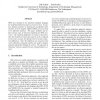Free Online Productivity Tools
i2Speak
i2Symbol
i2OCR
iTex2Img
iWeb2Print
iWeb2Shot
i2Type
iPdf2Split
iPdf2Merge
i2Bopomofo
i2Arabic
i2Style
i2Image
i2PDF
iLatex2Rtf
Sci2ools
ECOWS
2007
Springer
2007
Springer
Structural Matching of BPEL Processes
BPEL has emerged as the industrial standard language for modelling behavioral aspects of web services. To support business partners in dynamically and flexibly binding their services together, different BPEL processes need to be efficiently matched. This paper identifies and defines various types of structural matching for BPEL processes. The matching definitions are based on heuristics: they take behavioral interaction aspects of the compared services into account, but abstract from irrelevant syntactical differences. Since the definitions are structural, they can be efficiently computed, and thus are useful to support dynamic and flexible binding of services. The approach is illustrated with an example from an existing business scenario.
| Added | 07 Jun 2010 |
| Updated | 07 Jun 2010 |
| Type | Conference |
| Year | 2007 |
| Where | ECOWS |
| Authors | Rik Eshuis, Paul W. P. J. Grefen |
Comments (0)

